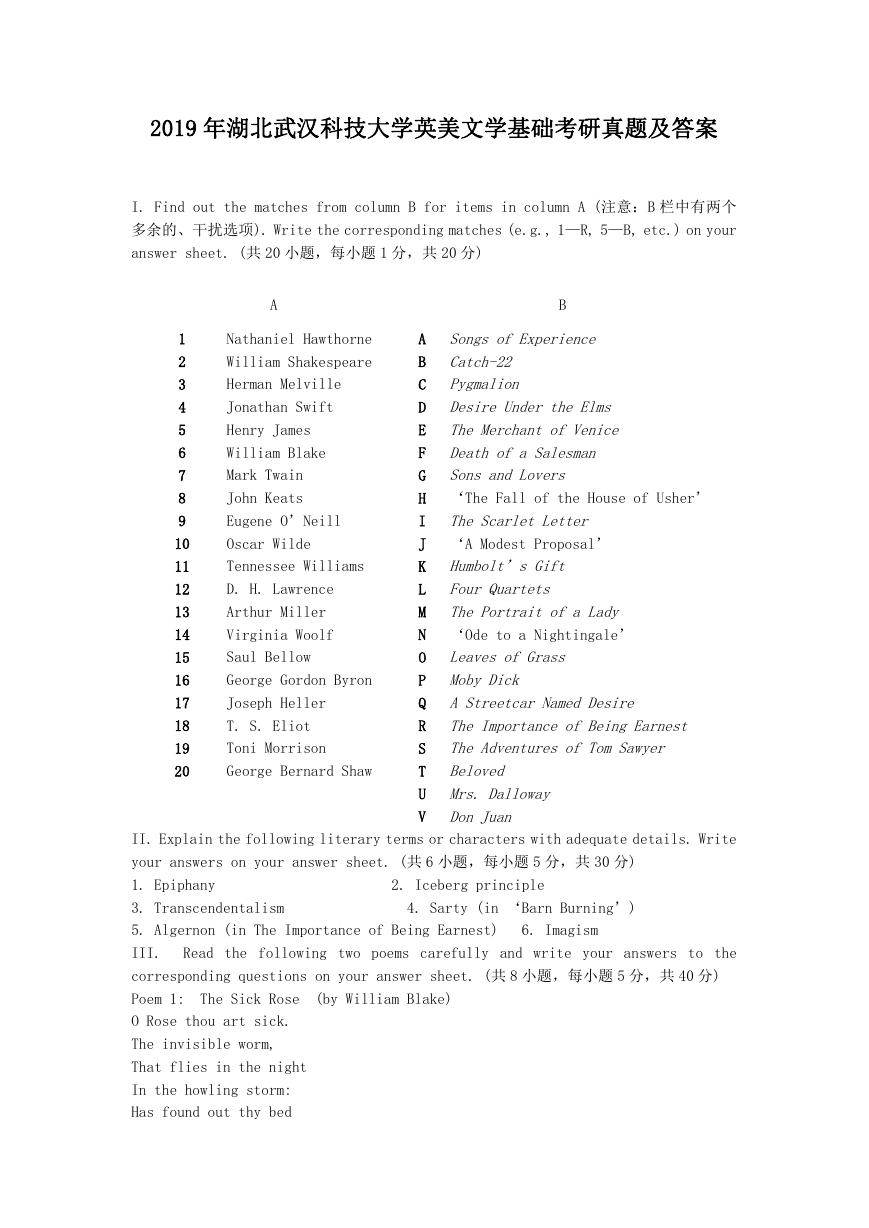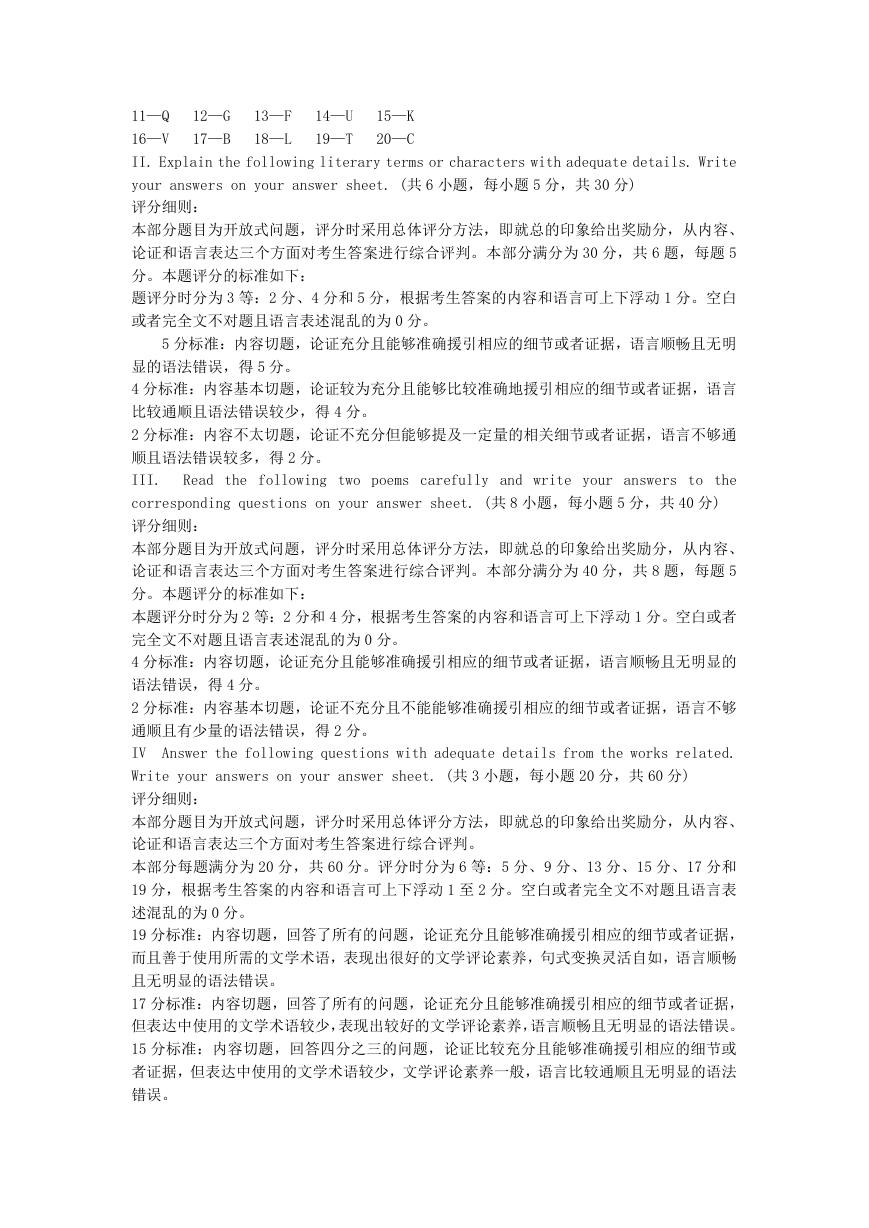2019 年湖北武汉科技大学英美文学基础考研真题及答案
I. Find out the matches from column B for items in column A (注意:B 栏中有两个
多余的、干扰选项). Write the corresponding matches (e.g., 1—R, 5—B, etc.) on your
answer sheet. (共 20 小题,每小题 1 分,共 20 分)
A
B
1
2
3
4
5
6
7
8
9
10
11
12
13
14
15
16
17
18
19
20
Nathaniel Hawthorne
William Shakespeare
Herman Melville
Jonathan Swift
Henry James
William Blake
Mark Twain
John Keats
Eugene O’Neill
Oscar Wilde
Tennessee Williams
D. H. Lawrence
Arthur Miller
Virginia Woolf
Saul Bellow
George Gordon Byron
Joseph Heller
T. S. Eliot
Toni Morrison
George Bernard Shaw
A Songs of Experience
B Catch-22
C Pygmalion
D Desire Under the Elms
E The Merchant of Venice
F Death of a Salesman
G Sons and Lovers
H ‘The Fall of the House of Usher’
I The Scarlet Letter
J ‘A Modest Proposal’
K Humbolt’s Gift
L Four Quartets
M The Portrait of a Lady
N ‘Ode to a Nightingale’
O Leaves of Grass
P Moby Dick
Q A Streetcar Named Desire
R The Importance of Being Earnest
S The Adventures of Tom Sawyer
T Beloved
U Mrs. Dalloway
V Don Juan
2. Iceberg principle
6. Imagism
4. Sarty (in ‘Barn Burning’)
Read the following two poems carefully and write your answers to the
II. Explain the following literary terms or characters with adequate details. Write
your answers on your answer sheet. (共 6 小题,每小题 5 分,共 30 分)
1. Epiphany
3. Transcendentalism
5. Algernon (in The Importance of Being Earnest)
III.
corresponding questions on your answer sheet. (共 8 小题,每小题 5 分,共 40 分)
Poem 1:
O Rose thou art sick.
The invisible worm,
That flies in the night
In the howling storm:
Has found out thy bed
The Sick Rose
(by William Blake)
�
Of crimson joy:
And his dark secret love
Does thy life destroy.
Questions 1 to 4 are based on the above poem :
1.In what sense do you think the rose is “sick”?
2.What do “the night” and “the storm” symbolize?
3.Why does the worm’s love destroy the rose?
4. In what sense is the rose responsible for its sickness?
Poem 2: Fire and Ice (by Robert Frost)
Some say the world will end in fire,
Some say in ice.
From what I’ve tasted of desire
I hold with those who favor fire.
But if it had to perish twice,
I think I know enough of hate
To say that for destruction ice
Is also great
And would suffice.
Questions 5 to 8 are based on the above poem:
4.What are the symbolic meanings of fire in this poem?
5.Why does the speaker say that ice is also great for destruction? Explain what ice
stands for here.
6.What is your opinion about fire and ice? Which one is more destructive? Why?
8. What does the poem suggest so that destruction could be avoided?
IV
Write your answers on your answer sheet.
1. What do you think Doris Lessing wants to say about the relationship between men
and women in modern society in “A Woman on a Roof”? Does she ever show any sympathy
to the three men in the story? How (if yes) or why not (if no)?
2.In what sense is Stephen Crane's “The Open Boat” a typical naturalist story?
What naturalist themes can be found in the story? How are the themes illustrated
in the story?
3.In Gulliver's Travels,what is the author’s attitude towards his master? How does
he feel to be a human being? Why do you think Yahoos are kept by the Houyhnhnms?
Answer the following questions with adequate details from the works related.
(共 3 小题,每小题 20 分,共 60 分)
答案
I. Find out the matches from column B for items in column A (注意:B 栏中有两个
多余的、干扰选项). Write the corresponding matches (e.g., 1—R, 5—B, etc.) on your
answer sheet. (共 20 小题,每小题 1 分,共 20 分)
评分细则:每空 1 分,共 20 分。
1—I
6—A
5—M
10—R
4—J
9—D
2—E
7—S
3—P
8—N
�
12—G
17—B
13—F
18—L
14—U
19—T
15—K
20—C
11—Q
16—V
II. Explain the following literary terms or characters with adequate details. Write
your answers on your answer sheet. (共 6 小题,每小题 5 分,共 30 分)
评分细则:
本部分题目为开放式问题,评分时采用总体评分方法,即就总的印象给出奖励分,从内容、
论证和语言表达三个方面对考生答案进行综合评判。本部分满分为 30 分,共 6 题,每题 5
分。本题评分的标准如下:
题评分时分为 3 等:2 分、4 分和 5 分,根据考生答案的内容和语言可上下浮动 1 分。空白
或者完全文不对题且语言表述混乱的为 0 分。
5 分标准:内容切题,论证充分且能够准确援引相应的细节或者证据,语言顺畅且无明
Read the following two poems carefully and write your answers to the
显的语法错误,得 5 分。
4 分标准:内容基本切题,论证较为充分且能够比较准确地援引相应的细节或者证据,语言
比较通顺且语法错误较少,得 4 分。
2 分标准:内容不太切题,论证不充分但能够提及一定量的相关细节或者证据,语言不够通
顺且语法错误较多,得 2 分。
III.
corresponding questions on your answer sheet. (共 8 小题,每小题 5 分,共 40 分)
评分细则:
本部分题目为开放式问题,评分时采用总体评分方法,即就总的印象给出奖励分,从内容、
论证和语言表达三个方面对考生答案进行综合评判。本部分满分为 40 分,共 8 题,每题 5
分。本题评分的标准如下:
本题评分时分为 2 等:2 分和 4 分,根据考生答案的内容和语言可上下浮动 1 分。空白或者
完全文不对题且语言表述混乱的为 0 分。
4 分标准:内容切题,论证充分且能够准确援引相应的细节或者证据,语言顺畅且无明显的
语法错误,得 4 分。
2 分标准:内容基本切题,论证不充分且不能能够准确援引相应的细节或者证据,语言不够
通顺且有少量的语法错误,得 2 分。
IV
Write your answers on your answer sheet. (共 3 小题,每小题 20 分,共 60 分)
评分细则:
本部分题目为开放式问题,评分时采用总体评分方法,即就总的印象给出奖励分,从内容、
论证和语言表达三个方面对考生答案进行综合评判。
本部分每题满分为 20 分,共 60 分。评分时分为 6 等:5 分、9 分、13 分、15 分、17 分和
19 分,根据考生答案的内容和语言可上下浮动 1 至 2 分。空白或者完全文不对题且语言表
述混乱的为 0 分。
19 分标准:内容切题,回答了所有的问题,论证充分且能够准确援引相应的细节或者证据,
而且善于使用所需的文学术语,表现出很好的文学评论素养,句式变换灵活自如,语言顺畅
且无明显的语法错误。
17 分标准:内容切题,回答了所有的问题,论证充分且能够准确援引相应的细节或者证据,
但表达中使用的文学术语较少,表现出较好的文学评论素养,语言顺畅且无明显的语法错误。
15 分标准:内容切题,回答四分之三的问题,论证比较充分且能够准确援引相应的细节或
者证据,但表达中使用的文学术语较少,文学评论素养一般,语言比较通顺且无明显的语法
错误。
Answer the following questions with adequate details from the works related.
�
13 分标准:回答五分之三的问题,且内容较为切题,论证比较充分且能够较好地援引相应
的细节或者证据,但表达中使用的文学术语很少,文学评论素养一般,语言比较通顺但有一
定的语法错误。
9 分标准:回答二分之一的问题,且内容较为切题,论证比较充分且能够较好地援引相应的
细节或者证据,语言不太通顺且有比较明显的语法错误。
5 分标准:内容不太切题,且只回答了四分之一左右的问题,论证不充分但能够提及一定量
的相关细节或者证据,语言不够通顺且语法错误较多。
�








 2023年江西萍乡中考道德与法治真题及答案.doc
2023年江西萍乡中考道德与法治真题及答案.doc 2012年重庆南川中考生物真题及答案.doc
2012年重庆南川中考生物真题及答案.doc 2013年江西师范大学地理学综合及文艺理论基础考研真题.doc
2013年江西师范大学地理学综合及文艺理论基础考研真题.doc 2020年四川甘孜小升初语文真题及答案I卷.doc
2020年四川甘孜小升初语文真题及答案I卷.doc 2020年注册岩土工程师专业基础考试真题及答案.doc
2020年注册岩土工程师专业基础考试真题及答案.doc 2023-2024学年福建省厦门市九年级上学期数学月考试题及答案.doc
2023-2024学年福建省厦门市九年级上学期数学月考试题及答案.doc 2021-2022学年辽宁省沈阳市大东区九年级上学期语文期末试题及答案.doc
2021-2022学年辽宁省沈阳市大东区九年级上学期语文期末试题及答案.doc 2022-2023学年北京东城区初三第一学期物理期末试卷及答案.doc
2022-2023学年北京东城区初三第一学期物理期末试卷及答案.doc 2018上半年江西教师资格初中地理学科知识与教学能力真题及答案.doc
2018上半年江西教师资格初中地理学科知识与教学能力真题及答案.doc 2012年河北国家公务员申论考试真题及答案-省级.doc
2012年河北国家公务员申论考试真题及答案-省级.doc 2020-2021学年江苏省扬州市江都区邵樊片九年级上学期数学第一次质量检测试题及答案.doc
2020-2021学年江苏省扬州市江都区邵樊片九年级上学期数学第一次质量检测试题及答案.doc 2022下半年黑龙江教师资格证中学综合素质真题及答案.doc
2022下半年黑龙江教师资格证中学综合素质真题及答案.doc